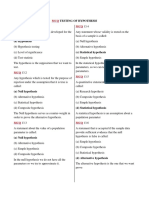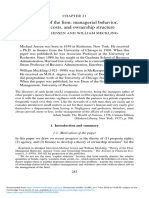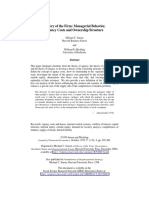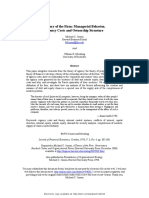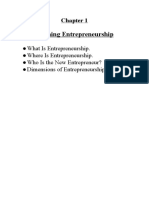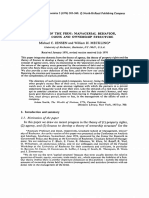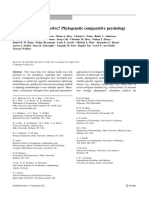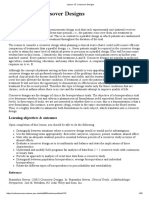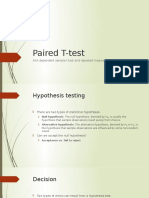Risk Taking Propensity of Entrepreneurs BROCKHAUS
Risk Taking Propensity of Entrepreneurs BROCKHAUS
Uploaded by
adibalCopyright:
Available Formats
Risk Taking Propensity of Entrepreneurs BROCKHAUS
Risk Taking Propensity of Entrepreneurs BROCKHAUS
Uploaded by
adibalOriginal Description:
Copyright
Available Formats
Share this document
Did you find this document useful?
Is this content inappropriate?
Copyright:
Available Formats
Risk Taking Propensity of Entrepreneurs BROCKHAUS
Risk Taking Propensity of Entrepreneurs BROCKHAUS
Uploaded by
adibalCopyright:
Available Formats
Risk Taking Propensity of Entrepreneurs Author(s): Robert H. Brockhaus, Sr. Source: The Academy of Management Journal, Vol.
23, No. 3 (Sep., 1980), pp. 509-520 Published by: Academy of Management Stable URL: http://www.jstor.org/stable/255515 . Accessed: 26/03/2014 07:48
Your use of the JSTOR archive indicates your acceptance of the Terms & Conditions of Use, available at . http://www.jstor.org/page/info/about/policies/terms.jsp
.
JSTOR is a not-for-profit service that helps scholars, researchers, and students discover, use, and build upon a wide range of content in a trusted digital archive. We use information technology and tools to increase productivity and facilitate new forms of scholarship. For more information about JSTOR, please contact support@jstor.org.
Academy of Management is collaborating with JSTOR to digitize, preserve and extend access to The Academy of Management Journal.
http://www.jstor.org
This content downloaded from 192.38.33.16 on Wed, 26 Mar 2014 07:48:10 AM All use subject to JSTOR Terms and Conditions
C? Academty of Management
Journal
1980, Vol. 23, No. 3, 509-520.
Risk
Taking Propensity of Entrepreneurs'
ROBERT H. BROCKHAUS, SR.
St. ILouis University
The risk takingpropensitiesof entrepreneurs of new ventures were objectively obtained using the KoganWallachchoice dilemmasquestionnaireand werecomand to normativedata develpared to those of managers instrument.Thefindings sugopedfor the measurement gest that risk takingpropensitymay not be a distinguishing characteristic of entrepreneurs. Theyrefuteassumptions based on research that has been subjective and noncomparativeand that used established entrepreneurs.
Palmer has suggested that psychological testing of entrepreneurs "be directed most toward the measurement of an individual's perception and handling of a risk" (1971, p. 38). The major purpose of the present research is to determine whether founders of new ventures and newly hired managers or newly promoted managers differ in their risk taking propensities. In order for this study to be understood completely, the varied definitions of the term "entrepreneur" must be presented and a functional definition for use in this study must be developed.
preneur as "the organizer of an economic venture, especially one who organizes, owns, manages, and assumes the risk of a business." Funk and Wagnall's Standard Dictionary (1958) offers a similar definition. It states that an entrepreneur is "one who undertakes to start and conduct an enterprise or business, assuming full control and risks." Schumpeter (1954) credits J. S. Mill with bringing the term into general use among economists. Mill (1848) included as entrepreneurial functions direction, control, superintendence, and risk bearing. Mill appeared to believe that the inclusion of risk bearing distinguished the term "entrepreneur" from the term " "manager.
Webster'sThirdNew International Dictionary(1961) defines an entre-
IAversion of this paper was presented at the annual Academy of Management meetings, Kansas City, 1976. The author would like to thank Walter Nord, Raymond Hilgert, Jerome Steinman, and Barry Anderson of Washington University for their helpful comments and advice.
509
This content downloaded from 192.38.33.16 on Wed, 26 Mar 2014 07:48:10 AM All use subject to JSTOR Terms and Conditions
510
Academy of Management Journal
September
In his own writings, Schumpeter stressed that the role of innovation was of major importance in defining the entrepreneur. He placed less emphasis on the role of risk because he believed that both entrepreneurs and managers are subject to the risk of failure. McClelland (1961) was less restrictive and did not require that the entrepreneur be the owner of the business. He believed that an innovative manager who has decision making responsibility is an entrepreneur. Thus in McClelland's terms a manager in a corporation can be entrepreneurial. However, Hartmann's (1959) thorough historical discussion of the differences between entrepreneur and manager found that a useful distinction can be made. He supported Weber's (1947) concept, which considered the entrepreneur the ultimate source of all formal authority within the organization. Such a definition, Weber stated, distinguished the entrepreneur from the manager. Most present day writers would consider the owner-manager of a business to be an entrepreneur. Today, it is further generally accepted that a person who provides capital would not be considered an entrepreneur if he did not also manage the venture. However, many authors, such as Collins and Moore (1964) and Hornaday and Aboud (1971) are even more restrictive in their studies and have examined only business ventures that were successful. Although it should be noted that different definitions do exist, the definition to be used in this study does not prevent the review of the findings based on somewhat different definitions. However, previous findings based on different definitions may not be true for those defined as entrepreneurs in this study. In this study, an entrepreneur is defined as a major owner and manager of a business venture who is not employed elsewhere. Such a definition allows for a more distinct comparison of the entrepreneur with the manager than would be obtained if managers with entrepreneurial-like positions were considered as entrepreneurs rather than managers. However, distinction between successful and unsuccessful entrepreneurs will not be made. Respondents were selected who very recently had made the decision to become owner-managers. For this reason, the validity of this study will not depend upon a venture's degree of success as would a study based upon entrepreneurs in business long enough to be considered successful or unsuccessful. ENTREPRENEURIAI, RISKS Liles (1974) speculated about what he believed is at risk in a new venture. He suggested that in becoming an entrepreneur an individual risks financial well-being, career opportunities, family relations, and psychic well-being. The personal financial obligations that the entrepreneur makes to an unsuccessful enterprise can result in major losses to the entrepreneur
This content downloaded from 192.38.33.16 on Wed, 26 Mar 2014 07:48:10 AM All use subject to JSTOR Terms and Conditions
1980
Brockhaus, Sr.
511
as an individual and could jeopardize his future standard of living. Moreover, because the entrepreneur is likely to have devoted himself to the venture at a personal level, the failure of the venture becomes, in effect, the failure of the individual and therefore can have major emotional consequences. Realizing that the financial and emotional consequences of failure could be devastating, Liles suggested that the potential entrepreneur is well advised to analyze carefully the risks associated with his specific business proposal and then to determine whether or not he is willing to undertake them. Liles concluded that the decision depends to a great extent upon the potential entrepreneur's perception of the risk involved. Risk Preferences Expectance theorists, especially Atkinson (1957), have stimulated much study of risk preferences. Atkinson's risk taking model is derived from the relationship that McClelland found between need for achievement and preference for moderate probabilities of success. Atkinson's model involves six variables: the subjective probability (i.e., expectance) of success (P), the subjective probability of failure (P,), the incentive value of success (I), the incentive value of avoiding failure (-I,), the achievement motive (Ms), and the motive to avoid failure (Mr). Atkinson assumed that I, is a positive linear function of difficulty and can be represented by (1 - P). He assumed further that -I, is a negative linear function of difficulty and can be represented by -P,. The variables are combined multiplicatively in the following equation: Resultant motivation = (M, x P, x I,) + (M, xPtx-It). The resultant motivation function has a maximum at P,= .5 if Ms is greater than M,. Where M, is greater than M,, the resultant motivation function would be a maximum either at the lowest value of P, or the highest value of P. The major prediction that follows from Atkinson's theory is that performance level should be greatest when there is greatest uncertainty about the outcome (when subjective probability of success is .50). This prediction should be true regardless of whether the motive to achieve or the motive to avoid failure is stronger within an individual. However, persons in whom the achievement motive is stronger should prefer intermediate risk, and those in whom the motive to avoid failure is stronger should avoid intermediate risk, preferring instead either very easy and safe undertakings or extremely difficult and speculative ones. This preference is based on the theory that an individual with a stronger motivation to avoid failure will tend either to succeed with the safe task or will be easily able to explain failure of a very speculative task without assuming personal blame, which he finds particularly painful. McClelland (1961) has stated that the situations in which an individual's degree of control or skill is most important are moderately risky situations rather than very risky or very certain ones. According to McClelland, the
This content downloaded from 192.38.33.16 on Wed, 26 Mar 2014 07:48:10 AM All use subject to JSTOR Terms and Conditions
512
Academy of Management Journal
Septemlber
individual needs no more than average ability to perform successfully the functions that fall within the limits of the safe end of the continuum, but no amount of skill can help in the situation of pure chance.
EntrepreineurialRisk Preferences
These three levels of risk preferences-low, intermediate or moderate, and high-could affect an individual's decision to start a business venture. Mancuso (1975) stated that individuals who are considered established entrepreneurstend to be moderate risk takers, but he did not provide empirical support for his viewpoint, nor did he suggest what the propensity for risk taking might have been at the time the entrepreneurial decision was made. Perhaps in some instances, as the entrepreneur becomes more aware of his business environment, he realizes that the venture has been more risky than he originally perceived it. As noted earlier, no studies have considered the risk taking propensity of individuals whose business ventures failed before becoming reasonably well established. These individuals may have considered their ventures to involve moderate or low risks, or they may have recognized the highly speculative nature of their proposed ventures and even believed that there was a greater likelihood for failure than for success. As stated above, if their motivation to avoid failure was very strong, they may have preferred to fail in a high-risk environment where failure could be explained without assuming personal blame, instead of in a more moderate risk setting, where they might more likely be blamed personally for failure. Previous researchers who studied established (and, therefore, at least moderately successful) entrepreneurs may have eliminated from their studies those entrepreneurs who chose high-risk ventures and failed, as well as those who started what they considered to be low-risk ventures and failed. Although previous research has not specifically compared the risk taking propensity of individuals who decided to start their own business venture with that of individuals not so inclined, research conducted by Meyer, Walker, and Litwin (1961), studied "managers" of shop operations in manufacturing plants and "staff specialists" to determine the relationship between measured motive patterns of individuals and their adjustment to particular job roles. The authors hypothesized that managers in jobs with definite entrepreneurial characteristics would score higher on a measure of need for achievement than would specialists whose jobs were nonentrepreneurial. Further, they hypothesized that in situations requiring decisions involving risk, the "entrepreneurs" would prefer risks with odds of success near 50-50, because previous research had shown this preference to be associated with achievement motivation. The study found that managers selected to represent the entrepreneurial role did show greater preference for intermediate risks on a risk preference questionnaire than did specialists of comparable age, education, and job level.
This content downloaded from 192.38.33.16 on Wed, 26 Mar 2014 07:48:10 AM All use subject to JSTOR Terms and Conditions
1980
Brockhaus, Sr.
513
If managersholding positions with entrepreneurial characteristics have level for moderate risks do whose than jobs specialists greaterpreferences are nonentrepreneurial, then perhapsthese findingscan be generalized to The writingspreviouslyreferredto may sugincludeactualentrepreneurs. have a strongerpreferencefor moderate gest that actual entrepreneurs risks. However,it is conceivablethat the preferencefor moderatelevelrisk is not associatedwith actual ownershipof a businessbut ratherwith the managerialdemands of any job. If this conjecture is true, then there should not be a significantdifferencein risk taking propensitiesbetween and managers whosejobs are entrepreneurial with the exowner-managers ception of ownership. literaturesince the writingsof Mill has included risk Entrepreneurial betweenthe functionsof a characteristic bearingas a majordistinguishing riskcan be divided managerand those of an entrepreneur. Entrepreneurial into three components:the generalrisk taking propensityof a potential the perceivedprobabilityof failure for a specific venture, entrepreneur, and the perceivedconsequencesof failure. Becausethe lattertwo components requireintimateknowledgeof the specific venturebefore they can be evaluated,a studybasedon themwould be verydifficultand verylikely subjectto uncontrolledindependentvariables.However, the generalrisk and managerscan be compared taking propensityof the entrepreneurs ento determinewhetherthis componentof risk distinguishes empirically from managers. trepreneurs
Definition of Risk Taking Propensity
For the purposeof this study, the propensityfor risktakingis definedas the perceivedprobabilityof receivingthe rewardsassociatedwith success of a proposedsituation, which is requiredby an individualbefore he will associatedwith failure,the alternative subjecthimselfto the consequences than the situationprovidingless rewardas well as less severeconsequences describe the situation that Such a best definition situation. might proposed when he decides to establisha new busifaces the potentialentrepreneur ness venture.
METHOD Participants
One group The study was conductedusing threegroupsof participants. was composed of individualswho within the three months prior to the study ceased working for their employersand at the time of the study owned as well as managedbusinessventures.Becausetheirbusinesseshad not existedlong enoughto have failed, a broadspectrumof entrepreneurs is included,i.e., those who will be successfuland those who will be unsuccessful.
This content downloaded from 192.38.33.16 on Wed, 26 Mar 2014 07:48:10 AM All use subject to JSTOR Terms and Conditions
514
Academy of ManagemtentJournal
September
The entrepreneurial group was compared with two groups of managers who were similar otherwise to the entrepreneurs. Members of both groups of managers also had changed positions within three months prior to the study. One group of managers had changed organizations, and the other had only changed positions within an organization. This study initially involved only these three groups, and a comparison of the entrepreneurs with a more general population was not planned prior to the study. However, after the initial data analysis was conducted, comparison with a more generalized population seemed desirable. The normative data obtained by Kogan and Wallach (1964) was used as the best available data approximating the general population.
Measurement Instrument
Wallach and Kogan (1959, 1961) developed the choice dilemmas questionnaire (CDQ) to obtain probability preferences in everyday life situations. On this test a subject is presented with 12 hypothetical situations. Each item requires the respondent to choose between a safe alternative and a more attractive but risky one. In addition, the respondent is asked to indicate the probability of success sufficient for him to select the risky alternative. A typical item is:
Mr. A, an electrical engineer, who is married and has one child, has been working for a large electronics corporation since graduating from college five years ago. He is assured of a lifetime job with a modest, though adequate, salary, and liberal pension benefits upon retirement. On the other hand, it is very unlikely that his salary will increase much before he retires. While attending a convention, Mr. A is offered a job with a small, newly founded company which has a highly uncertain future. The new job would pay more to start and would offer the possibility of a share in the ownership if the company survived the competition of the larger firms. Imagine that you are advising Mr. A. Listed below are several probabilities or odds of the new company's proving financially sound. Please check the lowest probability that you would consider acceptable to make it worthwhile for Mr. A to take the new job. The chances are I in 10 that the company will prove financially sound. The chances are 3 in 10 that the company will prove financially sound. _ The chances are 5 in 10 that the company will prove financially sound. The chances are 7 in 10 that the company will prove financially sound. _ The chances are 9 in 10 that the company will prove financially sound. ___ __ Place a check here if you think Mr. A should not take the new job no matter what the probabilities.
The items contained in the CDQ are not in any respect a representative sample of all possible items in the universe. Therefore, instruments similar to the CDQ could readily be constructed. There is no basis known for the creation of any other possible scale as a measure of risk taking propensity. The CDQ score summarizes the responses made to a particular set of 12 choice dilemmas. A maximum score of 120 is possible, and 12 is the minimum score. Lower scores are associated with less conservatism in risk taking situations. Kogan and Wallach (1964) reported reliabilities of .53 for the men and .62 for women using odd-even coefficients stepped up by the SpearmanBrown formula and considered to be adequate.
This content downloaded from 192.38.33.16 on Wed, 26 Mar 2014 07:48:10 AM All use subject to JSTOR Terms and Conditions
1980
Brockhaus, Sr.
515
Items from the CDQ have been extensively used by researchers of risk taking propensity. Unfortunately, all reported research in the United States that utilized all of the items has used college students or elderly persons as subjects. Thus a comparison of the results of the present research with the results of previous research is necessarily of limited value. However, after a thorough search of the literature, it was concluded that the most widely used and most appropriate instrument for the present research was the CDQ, despite its limitations. The limitations were determined to be of less importance because the primary purpose for inclusion of this instrument was to measure the relative differences between groups.
Proceduire
The businesses whose owners served as participants were selected from the listing of businesses licensed by St. Louis County, Missouri, during the months of August and September 1975. From this total listing of businesses, branch outlets of existing businesses were eliminated. Also eliminated were businesses that had been established previous to August but had recently relocated and were being licensed to do business at the new location. After this elimination procedure, the names of 93 businesses remained. Each of these businesses received a letter informing the owner of a meeting to be offered at four different times at the School of Business and Administration of Saint Louis University. One purpose, stated in the letter for the meeting, was to gather information anonymously about the beliefs, attitudes, and background of the business owners. The second purpose mentioned was to allow the owners to meet one another socially and exchange information. Each business was contacted by telephone to see if the owner would attend one of the meetings. If a business had more than one owner, the first one contacted by telephone was the only one who was considered for this study. Furthermore, if the owner was employed elsewhere he was eliminated from this study. A total of 58 questionnaires were either provided during the meetings or mailed to those entrepreneurs unable to attend a meeting. Of these, 31 were completed in usable form. Five others were returned but were not completed as requested and therefore were disregarded. The names of managers were obtained from St. Louis area newspaper articles that deal with personnel changes. Only one manager per organization was asked to serve as a participant. These managers received letters similar to those sent to the entrepreneurs except that these letters stated that managers were the focal point of the meetings. A total of 106 questionnaires were either provided during the meetings or mailed to managers unable to attend any of the sessions. Of the 51 questionnaires provided to the promoted managers, 38 were returned but 3 were not correctly completed, leaving 35 in usable form for the study. Of
This content downloaded from 192.38.33.16 on Wed, 26 Mar 2014 07:48:10 AM All use subject to JSTOR Terms and Conditions
516
Academty of Management Journal
September
the 55 managers who had joined a new organization, 40 returned questionnaires but 4 did not complete them correctly, leaving 36 in usable form. To allow both managerial groups to be equal in size to the group of entrepreneurs, four questionnaires from individuals promoted within an organization and five questionnaires from individuals who had recently joined a new organization were randomly selected and eliminated from further data analysis. It was necessary to determine whether significantly different results would have been obtained if all of the participants had responded. To make this assessment, two procedures were used. First, the data provided by each primary group of respondents who attended the meetings was compared with the data for the same primary group of respondents who mailed in their responses. No significant differences were found to exist between either segment of any of the three groups. Second, the types of businesses and/or positions held by respondents of each primary group were compared with those of nonrespondents for each primary group. Once again no apparent differences were observed. However, these comparisons do not assure that similar results would definitely have been obtained had all participants responded.
RESU ,'T'S
The null hypothesis developed for this study is presented below: Individuals who, within the past three months, have ceased working for their employers and now own as well as manage business ventures, will have the same risk-taking propensity as will a) individuals who, within the past three months, have ceased workingfor their employers and now are managersfor different employers, and b) individuals who, within the past three months, have assumed new managerial positions with the same firms with which they have been associated for a year or more. In order to test the hypothesis, data from the Kogan-Wallach CDQ were used. The mean CDQ score for the entrepreneurs was 71, while the transferred managers' mean score was 72.52, and the promoted managers' mean score was 66.97 (Table 1).
1I I'ABLE Meaiis a(nd Standard I)eviations on Kogan-Wallach
Choice I)ilemmas Questioiiiaire
Group Entrepreneurs Transferred managers Promoted managers Numlber of Respondents 31 31 31 Mean 71.00 72.52 66.97 Standard Deviation 11.94 12.19 10.84
This content downloaded from 192.38.33.16 on Wed, 26 Mar 2014 07:48:10 AM All use subject to JSTOR Terms and Conditions
1980
Brockhaus, Sr.
517
TABLE 2 of Summary Analysis of Variance on Kogan-Wallach Choice I)ilemmas Questioinnaire
Source of Variation Between group Within group Total dlJ 2 90 92 SS 509.87 12262.71 12772.58 MS 254.94 136.25 F 1.87 Level of Significance .1579
If the range of differences among the three group means was similar to the range reported by Kogan and Wallach (1964), there is a 73 percent probability that it would have been discovered. This probability of detection or "power" of the statistical test was based on the range of means reported by Kogan and Wallach, 3 groups of 31 participants each and a Type I error of 5 percent. Although no generally accepted convention for significant power value exists, Cohen (1969) recommended 80 percent but noted that values larger than 60 percent should be considered acceptable. It therefore is concluded that if a difference in risk taking propensity had existed it probably would have been discovered. A one-way analysis of variance test (Table 2) indicated that the CDQ scores of the three groups were not significantly different from each other. Therefore, the null research hypothesis was accepted in its entirety; the entrepreneurs appear to have the same risk taking propensity as managers. In order to understand more fully the significance of risk taking propensity as it relates to the decision to start a business venture, additional exploratory analysis was conducted using the CDQ scores of the entrepreneurs together with the mean scores and standard deviations reported by Kogan and Wallach (1964) for 114 undergraduate male students and 103 undergraduate female students. The chi-squared test of significance indicates that no significant difference exists at the .25 level of confidence between the distribution of the entrepreneurs' scores and those scores obtained from the Kogan-Wallach study, assuming normal distribution for the Kogan-Wallach data. A Kolmogorov confidence band with a confidence coefficient of 95 percent was established using the data reported by Kogan-Wallach and assuming that the data were normally distributed. All individual scores for entrepreneurs were found to lie within this band, as illustrated in Figure 1. It therefore is concluded that the distribution of risk taking propensity held by entrepreneurs is the same as the distribution of risk taking in the general population, i.e., the population used by Kogan-Wallach to establish norms for the CDQ instrument.
DISCUSSIO()N
The failure of risk taking propensity to distinguish entrepreneurs from managers appears to be a major deviation from the widely reported theory
This content downloaded from 192.38.33.16 on Wed, 26 Mar 2014 07:48:10 AM All use subject to JSTOR Terms and Conditions
518
A cademy of Management Journal
September
Kolmogorov
FIGURL I Conlfidence Band Based on Kogan-Wallach's and1( Plot of Eiinrepreneturs' CD)Q Scores
/
(C)Q I)ata
t")0
Entrepreneurs
,,,~
~Upper
Limit /
/'
(5
C)
X X =
->^---
Lower Limit
40
0 60
20
30
40
50
60
70
80
90
100
that entrepreneurs are the more moderate risk takers. However, the failure
to find differences does not imply that entrepreneurs are not moderate risk takers. In fact, a comparison of the responses on the CDQ of the entrepreneurs and the managers who participated in this study with data from the original Kogan and Wallach (1964) study revealed that both groups were best described as moderate risk takers because their scores were clustered around the mean score reported by Kogan and Wallach. However, if the entire range of scores obtained from entrepreneurs in this study are compared to the entire range of scores obtained in the Kogan-Wallach study an interesting comparison can be made: Figure 1 consists of a plot based on the scores obtained by entrepreneurs in this study compared with plots based on the Kogan-Wallach studies that were used to establish normative data. (The Kogan-Wallach plots were obtained by using the reported mean and standard deviations, and it is assumed that the Kogan-Wallach data were normally distributed.) This Kolmogorov confidence band indicates that the distribution of entrepreneurs' scores from this study and that of Kogan-Wallach subjects are not significantly different at the .05 level of confidence. In other words, the distribution of the risk taking propensity of the entrepreneurs of new ventures is similar to the distribution of risk taking propensity found to exist by Kogan and Wallach in a more general population. Thus, the data in
This content downloaded from 192.38.33.16 on Wed, 26 Mar 2014 07:48:10 AM All use subject to JSTOR Terms and Conditions
1980
Brockhaus, Sr.
519
this study indicate that the level of risk taking propensity does not distinguish new entrepreneurs either from managers or from the general population. Just as the majority of the established entrepreneurs who were interviewed in earlier studies, such as Mancuso's (1975) study, expressed a desire for moderate levels of risk, over 64 percent of the entrepreneurs in this current study were found to have a propensity for moderate levels of risk, as indicated by their CDQ scores' being within one standard deviation of the mean for the Kogan and Wallach subjects. However, by definition, approximately 68 percent of the general population also would be expected to have scores in this range. Thus earlier studies concerned with the entrepreneurs' risk taking propensity may have correctly found the majority of entrepreneurs to have a tendency toward moderate levels of risk, but they may have failed to recognize that this same characteristic is also true of the population in general. Therefore, although a majority of the entrepreneurs of established ventures may in fact have preferred moderate levels of risk, this preference need not be a distinguishing characteristic. But even this statement must be followed with several cautions. Because this study dealt with entrepreneurs of new ventures, it is possible that the risk taking propensity of established entrepreneurs might differ from that of a new entrepreneur. This difference might occur for several reasons. First, the process of being an entrepreneur may increase the desire for moderate levels of risk, thus causing a larger percentage of established entrepreneurs to appear to be moderate risk takers. Furthermore, those entrepreneurs who have a propensity for low or high levels of risk may tend to cease to be entrepreneurs at a greater rate than do those who have a propensity for moderate levels of risk. An additional source of error is introduced by certain difficulties already mentioned in using the data reported by Kogan and Wallach for comparison with data collected for this study. Despite the limitations of this present study and the need for additional research, the finding that general risk taking propensity does not distinguish entrepreneurs from nonentrepreneurs, if confirmed by future research, would result in the revision of the importance of a variable that is widely accepted as an entrepreneurial characteristic.
REFERENCES
1. Atkinson, J. W. Motivational determinants of risk taking behavior. Psychological Review, 1957, 64, 359-372. 2. Cohen, J. Statistical power analysis for the behavioral sciences. New York: Academic Press, 1969. 3. Collins, D. F., & Moore, D. G. The enterprising man. East Lansing, Mich.: MSU Business Studies, Michigan State University, 1964. 4. Funk and Wagnall's standard dictionary. International Edition. New York: Funk & Wagnall's Co., 1958. 5. Hartmann, H. Managers and entrepreneurs: A useful distinction? Administrative Science Quarterly, 1959, 3, 429-451.
This content downloaded from 192.38.33.16 on Wed, 26 Mar 2014 07:48:10 AM All use subject to JSTOR Terms and Conditions
520
Academy of Management Journal
September
6. Hornaday, J. A., & Aboud, J. Characteristics of successful entrepreneurs. Personnel Psychology, 1971, 24, 141-153. 7. Kogan, N., & Wallach, M. A. Risk taking. New York: Holt, Rinehart, and Winston, 1964. 8. Liles, P. R. New business ventures and entrepreneur. Homewood, 111.:Richard D. Irwin, Inc., 1974. 9. Mancuso, J. R. The entrepreneurs' quiz. In C. M. Baumback & J. R. Mancuso (Eds.), Entrepreneurship and venture management. Englewood, N.J.: Prentice-Hall, Inc., 1975. 10. McClelland, D. C. The achieving society. Princeton, N.J.: Van Nostrand, 1961, 226. 11. Meyer, H. H., Walker, W. B., & Litwin, G. H. Motive patterns and risk preferences associated with entrepreneurship. Journal of Abnormal and Social Psychology, 1961, 63, 570-574. 12. Mill, J. S. Principles of political economy with some of their applications to social philosophy. 1848. In J. A. Schumpeter (Ed.), History of economic analysis. New York: Oxford University Press, 1954. 13. Palmer, M. The application of psychological testing to entrepreneurial potential. California Management Review, 1971, 13 (3), 38. 14. Schumpeter, J. A. (Ed.). History of economic analysis. New York: Oxford University Press, 1954, 554-557. 15. Wallach, M. A., & Kogan, N. Sex differences and judgment processes. Journal of Personality, 1959, 27, 555-564. 16. Wallach, M. A., & Kogan, N. Aspects of judgment and decision-making: Interrelationships and changes with age. Behavioral Science, 1961, 6, 23-36. 17. Weber, M. The theory of social and economic organization. Edited and translated by A. M. Henderson & T. Parsons. New York: Free Press, 1947. 18. Webster's third new international dictionary. Unabridged. Chicago: Merriam Co., 1961.
This content downloaded from 192.38.33.16 on Wed, 26 Mar 2014 07:48:10 AM All use subject to JSTOR Terms and Conditions
You might also like
- Multivariate Data Analysis Hair Chapter 01 - US 7eDocument37 pagesMultivariate Data Analysis Hair Chapter 01 - US 7ePedro Luque80% (5)
- MCQ Testing of HypothesisDocument10 pagesMCQ Testing of HypothesisJosé Juan Góngora Cortés86% (7)
- Pages From First Aid (USMLE Step1) (2019)Document6 pagesPages From First Aid (USMLE Step1) (2019)George Russell0% (1)
- A Diagnostic Scoring System For Myxedema ComaDocument36 pagesA Diagnostic Scoring System For Myxedema ComaSarnings SalamNo ratings yet
- References - Basic Statistics Tales of Distributions (9th Edition)Document6 pagesReferences - Basic Statistics Tales of Distributions (9th Edition)LintangFakhruParadhatuNo ratings yet
- Take RisksDocument3 pagesTake RisksRENJITH RNo ratings yet
- Lecture 5 - Entrepreneurial PersonalityDocument15 pagesLecture 5 - Entrepreneurial PersonalityIbrahim MunirNo ratings yet
- Theories of Entrepreneurship (14.8.23)Document25 pagesTheories of Entrepreneurship (14.8.23)Himanshu SahdevNo ratings yet
- Theory of The Firm Managerial Behavior, Agency Costs, and Ownership StructureDocument21 pagesTheory of The Firm Managerial Behavior, Agency Costs, and Ownership Structureshintya dewiNo ratings yet
- Gautam Thapar EnterpreDocument4 pagesGautam Thapar Enterpremandhanya_bharat2220No ratings yet
- Perspective On EntrepreneurshipDocument2 pagesPerspective On Entrepreneurshipeduardo.moraes.ritterNo ratings yet
- Jensen MecklingDocument71 pagesJensen MecklingAllouisius Tanamera NarasetyaNo ratings yet
- 1994DS Self-EfficacyDocument16 pages1994DS Self-Efficacy1901213224phbsNo ratings yet
- Entrepreneurship in Islam1Document31 pagesEntrepreneurship in Islam1BZDRNo ratings yet
- Theory of The Firm PDFDocument78 pagesTheory of The Firm PDFCarmen PredaNo ratings yet
- Measuring The Entrepreneurial Level of The Businessmen - The Relationship Between Personal Traits and Entrepreneurial Level (#472582) - 557250Document19 pagesMeasuring The Entrepreneurial Level of The Businessmen - The Relationship Between Personal Traits and Entrepreneurial Level (#472582) - 557250Jada CameronNo ratings yet
- Risk-Taking Differences Among Entrepreneurs The Role of Entrepreneurial MotivationDocument11 pagesRisk-Taking Differences Among Entrepreneurs The Role of Entrepreneurial Motivationbelski898No ratings yet
- Chapter 1Document15 pagesChapter 1Elijah IbsaNo ratings yet
- Theory of The Firm - Managerial Behavior, Agency Costs, and Ownership Structure-1-40Document40 pagesTheory of The Firm - Managerial Behavior, Agency Costs, and Ownership Structure-1-40mutia.wNo ratings yet
- Theory of The Firm: Managerial Behavior, Agency Costs and Ownership StructureDocument81 pagesTheory of The Firm: Managerial Behavior, Agency Costs and Ownership StructureYusthinHobrowNo ratings yet
- Entrepreneurship DefinitionsDocument8 pagesEntrepreneurship DefinitionsalidarlooNo ratings yet
- Enterprise Risk ManagementDocument25 pagesEnterprise Risk Managementmorrisonkaniu8283No ratings yet
- EntrepreneuriatDocument12 pagesEntrepreneuriatencglandNo ratings yet
- Aproaches To Entrepreneurship 1. Psychological Aproach I) David C Mcclelland'S Motivational Needs TheoryDocument8 pagesAproaches To Entrepreneurship 1. Psychological Aproach I) David C Mcclelland'S Motivational Needs TheoryGraceNo ratings yet
- Entrepreneurship Unit 1Document14 pagesEntrepreneurship Unit 1Abhishek GargNo ratings yet
- Uncertainty, Risk Preference, and New-Venture StrategiesDocument12 pagesUncertainty, Risk Preference, and New-Venture StrategiesAmir SuhaimiNo ratings yet
- Theory of The Firm: Managerial Behavior, Agency Costs and Ownership StructureDocument79 pagesTheory of The Firm: Managerial Behavior, Agency Costs and Ownership StructureJ. RanNo ratings yet
- Douglas 2000Document21 pagesDouglas 2000Nicolás MárquezNo ratings yet
- Definition of Entrepreneur TodayDocument11 pagesDefinition of Entrepreneur TodayNarinder BansalNo ratings yet
- Jensen MecklingDocument78 pagesJensen MecklingVe Oo CeNo ratings yet
- NORC at The University of Chicago, Society of Labor Economists, The University of Chicago Press Journal of Labor EconomicsDocument33 pagesNORC at The University of Chicago, Society of Labor Economists, The University of Chicago Press Journal of Labor EconomicsrezasattariNo ratings yet
- Theories and Assumptions of Entrepreneurship - 0Document16 pagesTheories and Assumptions of Entrepreneurship - 0Clarissa Puguon-maslang PallayNo ratings yet
- Entrep Final ModuleDocument13 pagesEntrep Final ModuleRosalinda PañaNo ratings yet
- Bussiness Chapter 1Document9 pagesBussiness Chapter 1Bethelhem YetwaleNo ratings yet
- Aula 5. Item 2. Theory of The FirmDocument56 pagesAula 5. Item 2. Theory of The FirmJosie TotesNo ratings yet
- Victoria University of Bangladesh: Anstotheqno-1Document12 pagesVictoria University of Bangladesh: Anstotheqno-1Md Shadat HossainNo ratings yet
- 1967 Crises in A Developing OrganizationDocument15 pages1967 Crises in A Developing Organizationnilton_bfoNo ratings yet
- Entrepreneursare Not Bornnor MadeDocument9 pagesEntrepreneursare Not Bornnor MadesandalskatsNo ratings yet
- Entrepreneur - Wikipedia, The Free EncyclopediaDocument7 pagesEntrepreneur - Wikipedia, The Free EncyclopediaSokhemaNara0% (1)
- Behavioral Finance: Dycbabef313 Bsba 3 Year - 1St Semester 2020-2021Document49 pagesBehavioral Finance: Dycbabef313 Bsba 3 Year - 1St Semester 2020-2021Jonnafe Almendralejo IntanoNo ratings yet
- Entrepreneurial FolkloreDocument7 pagesEntrepreneurial FolkloreAryan MadheysiaNo ratings yet
- MbamDocument19 pagesMbamthekaustuvNo ratings yet
- Entrepreneurship Notes For BS - 4Document41 pagesEntrepreneurship Notes For BS - 4AR ABRUNo ratings yet
- Lorenzana Act2Document7 pagesLorenzana Act2jomelprofrubioNo ratings yet
- Entrepreneurial ResilienceDocument19 pagesEntrepreneurial Resiliencekaleem gpskNo ratings yet
- Jensen-Meckling JFE 1976Document56 pagesJensen-Meckling JFE 1976Franklin MantillaNo ratings yet
- Journal of Financial Economics Volume 3 Issue 4 1976 (Doi 10.1016 - 0304-405x (76) 90026-x) Michael C. Jensen William H. Meckling - Theory of The Firm - Managerial Behavior, Agency Costs and OwnersDocument56 pagesJournal of Financial Economics Volume 3 Issue 4 1976 (Doi 10.1016 - 0304-405x (76) 90026-x) Michael C. Jensen William H. Meckling - Theory of The Firm - Managerial Behavior, Agency Costs and OwnersDiploma IV KeuanganNo ratings yet
- Theory: of TheDocument69 pagesTheory: of TheJulyanto Candra Dwi CahyonoNo ratings yet
- Entrepreneurship 4Document4 pagesEntrepreneurship 4Noemi Elgincolin ManlapazNo ratings yet
- ENT 211 - ADDITIONAL MATERIALSDocument75 pagesENT 211 - ADDITIONAL MATERIALStemisoreidowuNo ratings yet
- Received January 1976, Revised Version Received July 1976Document55 pagesReceived January 1976, Revised Version Received July 1976nadiaNo ratings yet
- One linerDocument5 pagesOne linerAnway PatraNo ratings yet
- Markowitz 1991Document10 pagesMarkowitz 1991Muntazir HussainNo ratings yet
- Failing Firms and Successful Entrepreneurs: Serial Entrepreneurship As A Temporal PortfolioDocument19 pagesFailing Firms and Successful Entrepreneurs: Serial Entrepreneurship As A Temporal PortfolioAsifMahbubNo ratings yet
- Entrepreneurship Module 1Document80 pagesEntrepreneurship Module 1Tasebe GetachewNo ratings yet
- 21 - Rsik Management1Document93 pages21 - Rsik Management1rajesh bathulaNo ratings yet
- Steven Cardona Assessment 1 1 5Document6 pagesSteven Cardona Assessment 1 1 5Marjorie PalmaNo ratings yet
- 2004 SO XuRuefDocument43 pages2004 SO XuRuefMarcos BalmacedaNo ratings yet
- Solving for Project Risk Management: Understanding the Critical Role of Uncertainty in Project ManagementFrom EverandSolving for Project Risk Management: Understanding the Critical Role of Uncertainty in Project ManagementNo ratings yet
- Building Resilience for Success: A Resource for Managers and OrganizationsFrom EverandBuilding Resilience for Success: A Resource for Managers and OrganizationsNo ratings yet
- Cohen, J. (1994) The Earth Is Round (Hypothesis Significance Testing)Document7 pagesCohen, J. (1994) The Earth Is Round (Hypothesis Significance Testing)Eduardo MoraNo ratings yet
- Journal of Biomechanics: Dimitrios Voukelatos, Mathew Kirkland, Matthew T.G. PainDocument7 pagesJournal of Biomechanics: Dimitrios Voukelatos, Mathew Kirkland, Matthew T.G. PainAzaldyNo ratings yet
- How To Get Your Paper Accepted For Publication PDFDocument3 pagesHow To Get Your Paper Accepted For Publication PDFLíviaSantosNo ratings yet
- Course PDFDocument403 pagesCourse PDFlubiandiegoNo ratings yet
- Improves Explosive StrengthDocument20 pagesImproves Explosive Strengthapi-31314862No ratings yet
- Testing An Expanded Attitude Model of Goal-Directed Behavior in A Loyalty ContextDocument22 pagesTesting An Expanded Attitude Model of Goal-Directed Behavior in A Loyalty ContextjoannakamNo ratings yet
- Ironman Pacing Strategy PDFDocument9 pagesIronman Pacing Strategy PDFRonald GeorgeNo ratings yet
- Is The Risk of Bankruptcy A Systematic Risk?Document17 pagesIs The Risk of Bankruptcy A Systematic Risk?Lucas NogueiraNo ratings yet
- 2012-Maclean Etal Phylogenetics PDFDocument16 pages2012-Maclean Etal Phylogenetics PDFNenad MilosevicNo ratings yet
- Risk Taking Propensity of Entrepreneurs BROCKHAUSDocument13 pagesRisk Taking Propensity of Entrepreneurs BROCKHAUSadibal100% (1)
- Leicester University Ec 3064 Project TemplateDocument61 pagesLeicester University Ec 3064 Project TemplateAidan J MurphyNo ratings yet
- Tests For The Ratio of Two Poisson RatesDocument15 pagesTests For The Ratio of Two Poisson RatesscjofyWFawlroa2r06YFVabfbajNo ratings yet
- Dan Dillon Homework Problem #7 - Part 2 STAT 582, Statistical Consulting and Collaboration Dr. JenningsDocument12 pagesDan Dillon Homework Problem #7 - Part 2 STAT 582, Statistical Consulting and Collaboration Dr. JenningspamfrrNo ratings yet
- Levine Smume7 Bonus Ch09Document6 pagesLevine Smume7 Bonus Ch09Kiran SoniNo ratings yet
- Sample Size: From Wikipedia, The Free EncyclopediaDocument4 pagesSample Size: From Wikipedia, The Free Encyclopediachemist_tmaNo ratings yet
- Lesson 15 - Crossover DesignsDocument20 pagesLesson 15 - Crossover DesignsLYNDSCNo ratings yet
- Weir 2005 JSCR Reliability PDFDocument10 pagesWeir 2005 JSCR Reliability PDFhenriqueNo ratings yet
- Chapleau and Oswald Power Sex and Rape Myth AccetanceDocument14 pagesChapleau and Oswald Power Sex and Rape Myth AccetanceShika ChristianNo ratings yet
- D Chesher - Troubleshooting Failed Quality Control PDFDocument34 pagesD Chesher - Troubleshooting Failed Quality Control PDFWaleed El-azabNo ratings yet
- Two-Sample T-Tests Using Effect SizeDocument11 pagesTwo-Sample T-Tests Using Effect SizescjofyWFawlroa2r06YFVabfbajNo ratings yet
- Paired T-Test: AKA Dependent Sample T-Test and Repeated Measures T-TestDocument17 pagesPaired T-Test: AKA Dependent Sample T-Test and Repeated Measures T-TestSoh Mei LingNo ratings yet
- Ancova 2Document8 pagesAncova 2Hemant KumarNo ratings yet
- Data PreparationDocument38 pagesData PreparationGarvit Dhingra100% (1)
- JMP Doe GuideDocument162 pagesJMP Doe GuideAru Manikam100% (1)
- LAPOP's Response To David Rosnick, Alexander Main and Laura JungDocument14 pagesLAPOP's Response To David Rosnick, Alexander Main and Laura JungInSight CrimeNo ratings yet

